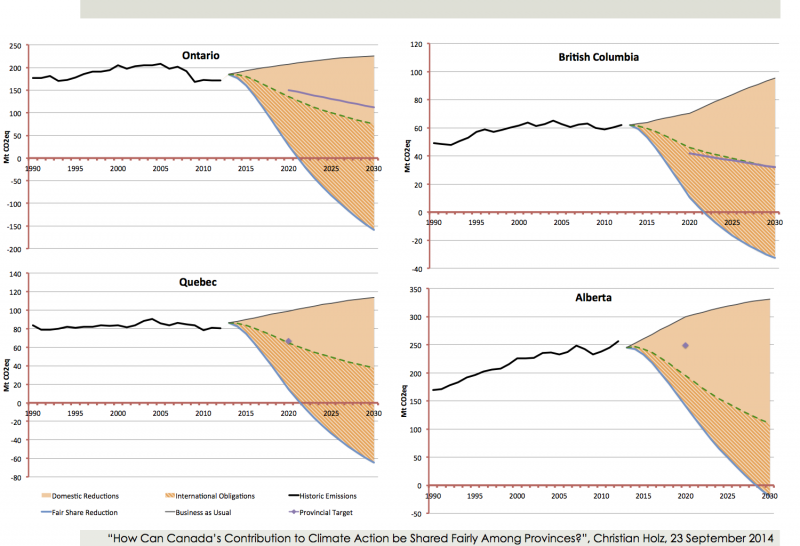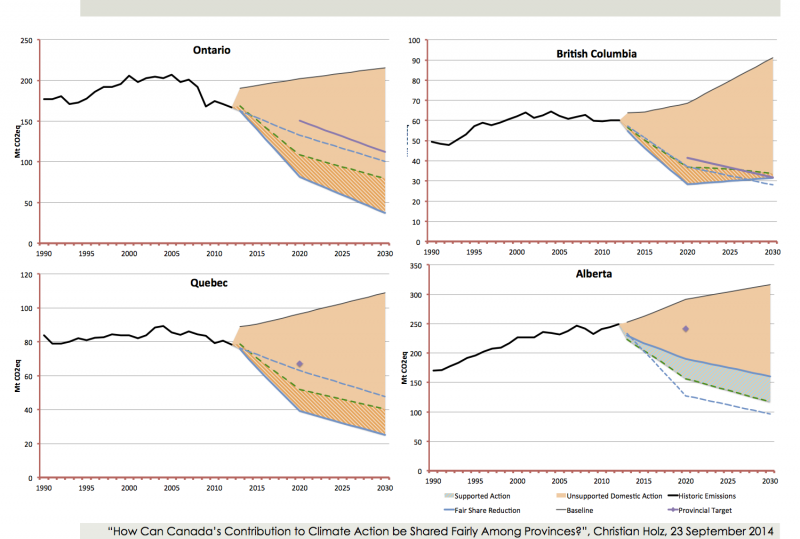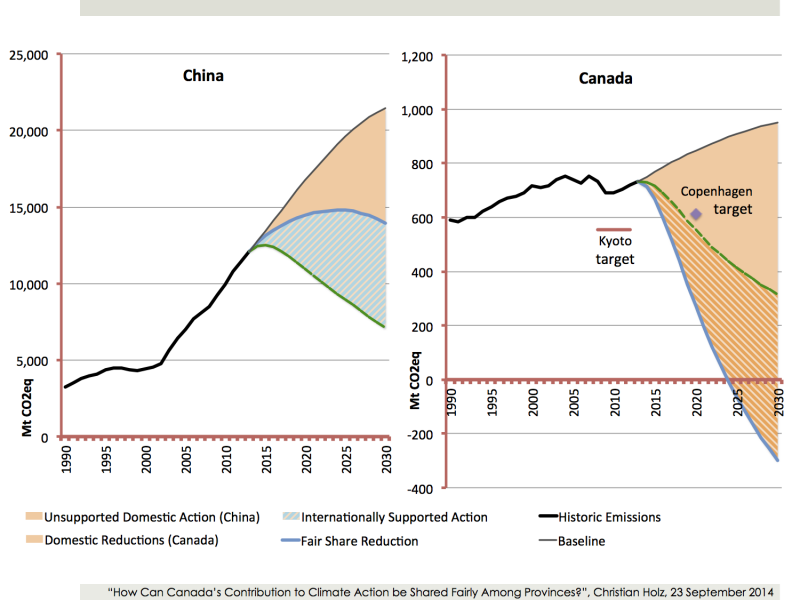How Can Canada’s Contribution to Climate Action be Shared Fairly among Provinces?
[This is a summary of a talk that I gave on September 23, 2014 at the University of Ottawa’s Centre of International Policy Studies, audio of the talk is available on their site]]
((The author of this post welcomes any inquiries or feedback with regards to this post at cholz@uottawa.ca)), ((The research presented here is part of my postdoctoral research project, funding for which comes from the Social Sciences and Humanities Research Council (SSHRC). The calculations presented here make heavy use of the Climate Equity Reference framework, developed by Paul Baer, Tom Athanasiou, Sivan Kartha and Eric Kemp-Benedict, and their Climate Equity Calculator. The database used for the calculations is a heavily altered version of their Climate Equity Calculator Database, augmented for the Canadian calculations with data from Statistics Canada (for population [1], [2], Gini efficients [3] and historical GDP data [4]), The Conference Board of Canada (for GDP forecasts [5]–[7]), Environment Canada (for historic [8] greenhouse gas emissions data). The “no policies” emissions baselines are constructed using historic data from Environment Canada [8] and emissions projections from Natural Resources Canada [9] and Environment Canada [10].)) Climate change mitigation necessitates effort sharing. Consequently, one of the most crucial questions for climate change politics is: How can different political entities fairly share the overall effort to reduce greenhouse gas emissions? On the global scale, the overall effort must be shared between countries or groups of countries. In political federations, such as Canada, provinces and territories must decide how to share the overall undertaking of reducing greenhouse gas emissions. Arguably, the current failure of Canada to live up to its international climate commitments [11], [12] can be at least partially attributed to the break-down in federal-provincial-territorial dialogue on climate change in the early 1990s [13], [14]. In a recent talk (slides here), co-hosted by CIPS and IPEN, I presented some early results from my current research that aims to help reinvigorating this dialogue by applying some of the lessons learned from the mature discourse on effort sharing on the global level to the Canadian inter-provincial effort sharing context.
Specifically, the aim was to investigate which insights the application of the Climate Equity Reference framework to the Canadian case could provide. In order to address this question, I will quickly explain the framework before talking about lessons for the Canadian case. In a nutshell, this framework, a recent generalization of its better known predecessor, Greenhouse Development Rights [15]–[17], takes explicit design clues from the equity principles of the UN Framework Convention on Climate Change [18] and translates them into specific equity indicators that can be further operationalized through readily available data for calculations of “fair shares” of countries to the global effort (Figure 1). While the framework itself is agnostic about the specifics of such operationalizations, the starting point is a global emission reductions pathway which determines the overall effort required collectively from all countries. It is important to note that in this approach the effort, both globally as well as for individual countries, is expressed relative to a “no policies” baseline, which describes a counter-factual future in which no single climate policy measure will ever be, or has ever been, implemented.
For each country, then, its percentage share of the overall global capacity that can be justifiably mobilized for action on climate change is calculated; conceptualized as all incomes above a certain threshold, in my case $7500PPP annually per capita. Likewise, the percentage share of the overall global responsibility for creating the climate problem is calculated for each country, conceptualized as the cumulative emissions from a certain start date, in my case 1990. These two figures are then combined into a Responsibility-Capacity-Index, in my case with equal weight, which is essentially a country’s share of the world’s collective responsibility for the creation of the climate problems and it’s collective capacity to act to resolve it. This percentage share can then be applied to the overall global effort required to arrive at a country’s “fair share” as defined by the specific operationalization chosen. ((For a more detailed treatment of the relationship between the climate convention’s core equity principles and operationalizable equity indicators, see [19]. For discussions on different options for operationalizing equity indicators, e.g. different responsibility start dates, development income thresholds etc., see [20], [21], [17], [15]. For more information on the very stringent emissions reductions pathway chosen here, that can still just about be defended as techno-economically feasibly, see [22], [23]))
When plotting country’s fair shares against their “no-policy” baselines, it becomes clear that there is a group of countries, including Canada, that have a high level of responsibility and/or capacity and therefore their fair share contribution would be larger than the amount of emissions reductions that could feasibly be implemented within their own borders (Figure 2, right panel). In order to nevertheless embrace their fair share, under this framework, these countries would have to ensure emissions reductions in other countries whose fair share, that is reductions they would be expected to undertake with their own means, is less than the level of emissions reductions that could be conceivably undertaken there (Figure 2, left panel illustrates that case). Such “internationally supported action” could take many forms, but essentially entails an entity from the first type of countries, governmental or non-governmental, providing support for emissions reductions in the second type of country, through financial or technology transfers, capacity building, enactment of enabling policy environments, direct foreign investment etc. ((With regards the dotted green line which delineates domestic effort and provision of international support for countries like Canada and indicates the overall emissions reductions (independently implemented as well as internationally supported) for countries like China it is important to note that the line is for illustration only and is drawn by applying the relative reduction below the baseline that the global case requires to the individual countries. In practice, this line would probably reflect different cost levels of emissions reductions, different reduction potentials as well as considerations of sovereignty and domestic politics for both supporters and recipients of international support, among other considerations.))
Turning the attention now to the application of this approach to effort sharing among Canadian provinces, the first set of results (Figure 3) is derived from treating all ten Canadian provinces (plus the territories) as if they were independent entities within a global context and replacing the entity “Canada” with these eleven subnational entities in the calculations. There are three main take-homes from this set of results.
First, which is not surprising if we think about it from a responsibility and capacity perspective in a global context, all Canadian provinces have a fair share that is too large to discharge within their own borders – notice how all of the “fair share” trajectories dip below zero. In other words, in addition to domestic action, all provinces will have to ensure that additional emission reductions are undertaken elsewhere on the planet, by providing enabling support for that.
Second, we can see the specific effects of the approach to conceptualize overall effort as the effort to deviate from a counter-factual “no policies” baseline: Because in the case of Ontario and Quebec the baseline is one of relative modest future emissions growth, their fair shares go much deeper into the negative than Alberta or BC, both of which have stronger emissions growth baselines. This implicitly takes into account that it is harder to cut emissions in absolute terms in places where there are economic drivers that push into the opposite direction. In this context it is important to keep in mind, that these are counterfactual baselines of a future in which no climate policies have ever been implemented. In reality, all these provinces actually have already undertaken some climate actions and certain federal policies that are already having, or are expected to have, an impact on emissions. In other words, some of the domestic effort expected from provinces is already already realized in the current policy configuration.
The third important take home is related to the provincial targets (the purple lines and dots in Figure 3): In many cases the provincial targets are actually close to what this analysis would expect provinces to accomplish within their own borders. That means in the case of the provinces where this actually is the case, the main conclusion is that the international support dimension would need to be added to the overall provincial undertaking.
All this shows that we can use a formalized model of global effort sharing to draw interesting conclusions for what each Canadian province should be fairly expected to contribute to a global effort. To my knowledge this has not been done before and I think can greatly help the discussion about effort sharing in Canada.

Figure 3: Selected Canadian provinces treated as independent entities in global context (Slide from September 23 Presentation)
However, the model also allows for analysis of Canada in isolation, for example by examining effort sharing between Canadian provinces and territories of a domestic Canadian target. Figure 4 shows the results of such an analysis for the same set of provinces. Since the federal government has not announced such a domestic target for Canada for the post-2020 period, I am using here the only Canada-wide emissions trajectory that is currently on the table federally, that contained in the NDP’s private member’s bill C-619. ((C-619 contains a mid term target of 35% below 1990 for 2025 and 80% below 1990 as a long-term target for 2050. Since C-619 is the third incarnation of Jack Layton’s original climate change accountability act, C-377, I assume that the authors of the bill are still embracing the 2020 target from C-377, 25% below 1990, especially since the 2025 target in C-619 lies on a straight line from that 2020 target to the 2050 long-term target that both versions of the bill share. The trajectory from 2025 to 2030 is also derived from that same straight line.)) The drawback of using the Climate Equity Reference framework to analyze Canada in isolation is that it cannot be assessed whether the resulting overall effort is actually sufficient to address the climate crisis since that is a function of the actions of all countries and not Canada alone. With that caveat, we can look at how that domestic Canadian emissions reductions objective could be shared among provinces.
The graphs clearly show that in the same group of four provinces, Alberta (along with Saskatchewan, Nova Scotia, and New Brunswick) does now belong to a different category than the others. Specifically, we can say that the fair share of this category of provinces, when taking into account historical responsibility and capacity, is less than what they would be under a uniform application of the same reduction rate – as represented by the dotted lines. ((The green dotted line applies the pan-Canadian target to provinces as specified by bill C-619: as same percentage reductions for each province below its own 1990 base year level of emissions. The blue dotted line applies the same reduction relative to the “no-policies” baseline that the bill implies for the whole of Canada to each province’s “no-policies” baseline.)) On the other hand, in places like Ontario, BC and Quebec (as well as Manitoba ((New Foundland and Labrador falls in its own category in that “domestic” reductions and fair share match, while data for the Territories is inconclusive.))), this assessment of fair shares under consideration of responsibility and capacity would require these places to do more than if a uniform reduction rate were applied to their baselines.
In the absence of other countries in the model, these results are a bit less straightforward to interpret than in the global case. But essentially this could mean two things: either the shaded areas are conceptualized just as in the global case as action that takes places in one province (here: Alberta et al.) but is enabled, for example by financial or technology transfer, by another province (e.g. Ontario, Quebec or BC). Alternatively, the shaded areas could be ignored and every province would be required to ensure that their own fair share reduction is realized within their boundaries, which seems to be the more appropriate application in the Canadian case.

Figure 4: Selected Canadian provinces’ fair share of a domestic Canadian emissions reduction effort (Slide from September 23 Presentation)
Either way, the application of a strictly equity-centered approach to effort sharing in Canada clearly can enhance the discussion of how a Canadian effort can be shared among its provinces once Canadian governments decide to re-establish a federal-provincial-territorial dialogue on climate change.
REFERENCES
[1] Statistics Canada, “Table 052-0005 – Projected Population, by Projection Scenario, Sex and Age Group as of July 1, Canada, Provinces and Territories, Annual (persons X 1,000), CANSIM (Database).” 25-May-2010 [Online]. Available: http://www5.statcan.gc.ca/cansim/a47. [Accessed: 12-Mar-2014]
[2] Statistics Canada, “Table 051-0001 – Estimates of Population, by Age Group and Sex for July 1, Canada, Provinces and Territories, Annual (persons), CANSIM (database).” Statistics Canada, 25-Nov-2013 [Online]. Available: http://www5.statcan.gc.ca/cansim. [Accessed: 07-Mar-2014]
[3] Statistics Canada, “Table 202-0705 – Gini Coefficients of Market, Total and After-Tax Income, by Economic Family Type, Annual (number), CANSIM (database).” Statistics Canada, 27-Jun-2013 [Online]. Available: http://www5.statcan.gc.ca/cansim. [Accessed: 07-Mar-2014]
[4] Statistics Canada, “Table 384-0038 – Gross Domestic Product, Expenditure-Based, Provincial and Territorial, Annual (Dollars Unless Otherwise Noted), CANSIM (Database).” Statistics Canada, 08-Nov-2013 [Online]. Available: http://www5.statcan.gc.ca/cansim. [Accessed: 07-Mar-2014]
[5] Conference Board of Canada, “Provincial Outlook Economic Forecast: Autumn 2013,” The Conference Board of Canada, Ottawa, Jan. 2014 [Online]. Available: http://www.conferenceboard.ca/e-library/abstract.aspx?did=5937
[6] Conference Board of Canada, “Provincial Outlook Long-Term Economic Forecast 2013,” The Conference Board of Canada, Ottawa, 2013.
[7] Conference Board of Canada, “Canadian Outlook Long-Term Forecast 2013: Economic Forecast,” The Conference Board of Canada, Ottawa, 2013.
[8] Environment Canada, “National Inventory Report 2014,” Environment Canada, Gatineau, Apr. 2014 [Online]. Available: https://unfccc.int/files/national_reports/annex_i_ghg_inventories/national_inventories_submissions/application/zip/can-2014-nir-11apr.zip
[9] Natural Resources Canada, Canada’s Energy Outlook. The Reference Case 2006. Ottawa: Natural Resources Canada, Analysis and Modelling Division, 2006.
[10] Environment Canada, “Sixth National Communication to the United Nations Framework Convention on Climate Change.” 20-Dec-2013 [Online]. Available: http://unfccc.int/files/national_reports/non-annex_i_natcom/submitted_natcom/application/pdf/final_nc_br_dec20,_2013[1].pdf
[11] Commissioner of the Environment, “2014 Fall Report of the Commissioner of the Environment and Sustainable Development, Chapter1: Mitigating Climate Change,” Office of the Auditor General, Ottawa, Oct. 2014 [Online]. Available: http://www.oag-bvg.gc.ca/internet/English/parl_cesd_201410_e_39845.html
[12] Environment Canada, Canada’s Emissions Trends 2013. Gatineau: Environment Canada, 2013 [Online]. Available: http://ec.gc.ca/Publications/default.asp?lang=En&xml=1723EA20-77AB-4954-9333-69D1C4EBD0B2. [Accessed: 02-Mar-2014]
[13] D. Macdonald, J. Monstadt, and K. Kern, Allocating Canadian Greenhouse Gas Emission Reductions Amongst Sources and Provinces. Learning from the EU, Australia and Germany. Toronto: University of Toronto, 2013 [Online]. Available: http://www.environment.utoronto.ca/AllocatingGHGReductions2013/. [Accessed: 09-Sep-2013]
[14] C. Böhringer, N. Rivers, T. Rutherford, and R. Wigle, “Sharing the Burden for Climate Change Mitigation in the Canadian Federation,” Canadian Journal of Economics, forthcoming.
[15] T. Athanasiou, P. Baer, and S. Kartha, “Greenhouse Development Rights: An Approach to the Global Climate Regime That Takes Climate Protection Seriously While Also Preserving the Right to Human Development,” EcoEquity; Christian Aid, 2006 [Online]. Available: http://gdrights.org/wp-content/uploads/2009/03/gdrs_nairobi.pdf
[16] P. Baer, T. Athanasiou, S. Kartha, and E. Kemp-Benedict, “The Greenhouse Development Rights Framework. The Right to Development in a Climate Constrained World, Second Edition,” Heinrich Böll Foundation, Christian Aid, EcoEquity and the Stockholm Environment Institute, Berlin, Nov. 2008 [Online]. Available: http://www.ecoequity.org/docs/TheGDRsFramework.pdf. [Accessed: 08-Feb-2009]
[17] S. Kartha, T. Athanasiou, and P. Baer, “The North-South Divide, Equity and Development – The Need for Trust- Building for Emergency Mobilisation,” in What Next Volume III: Climate, Development and Equity, N. Hällström, Ed. Uppsala: The Dag Hammarskjöld Foundation, 2012, pp. 47–71 [Online]. Available: http://www.dhf.uu.se/publications/development-dialogue/dd61/
[18] UNFCCC, “United Nations Framework Convention on Climate Change.” UNFCCC, 1992 [Online]. Available: http://unfccc.int/resource/docs/convkp/conveng.pdf. [Accessed: 15-Feb-2008]
[19] CAN, “The Core Convention-Based Equity Indicators,” Climate Action Network International, Beirut, 2013 [Online]. Available: http://climatenetwork.org/publication/can-core-convention-based-equity-indicators
[20] E. Kemp-Benedict, P. Baer, T. Athanasiou, and S. Kartha, “Climate Equity Reference Calculator – Glossary,” 2014. [Online]. Available: http://gdrights.org/calculator/glossary.php
[21] E. Kemp-Benedict, T. Athanasiou, P. Baer, and S. Kartha, “Calculations for the Greenhouse Development Rights Calculator,” Stockholm Environmental Institute; EcoEquity, Feb. 2013.
[22] P. Baer, T. Athanasiou, and S. Kartha, “Three Salient Global Mitigation Pathways, Assessed in Light of the IPCC Carbon Budgets,” Jan-2014. [Online]. Available: http://gdrights.org/gdrs-scorecard-calculator-information/mitig-path-overview/. [Accessed: 20-Feb-2014]
[23] N. Höhne, P. van Breevoort, Y. Deng, J. Larkin, and G. Hänsel, “Feasibility of GHG Emissions Phase-Out by Mid-Century,” Prepared by Ecofys for Global Call for Climate Action, Cologne, Project No. CLIDE14075, Oct. 2013 [Online]. Available: http://www.ecofys.com/en/publication/feasibility-of-ghg-emissions-phase-out-by-mid-century. [Accessed: 07-Oct-2014]

